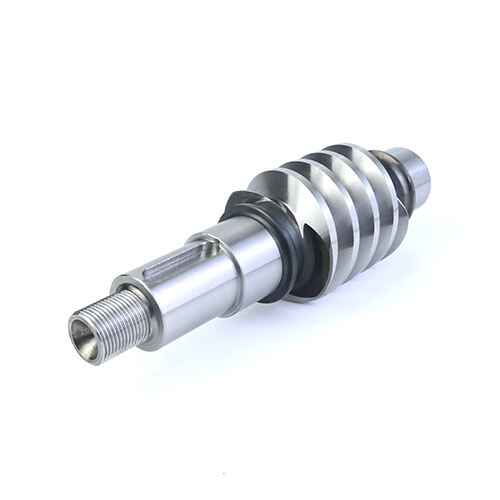Ինչ է CNC նմուշը
Այսօրվա մրցակցային արտադրության շրջակա գոտում գաղափարները արագ վերածել կոնկրետ բաղադրիչների, որը արդյունաբերության առաջատար ընկերություններին տարանջատում է հետևորդներից: CNC մոդելավորում նախամշակման ստուգման ոսկե ստանդարտ է դարձել՝ առաջարկելով աննախադեպ ճշգրտություն և նյութերի բազմազանություն: Քանի որ մենք առաջ ենք գնում 2025 թվականի ընթացքում, այս տեխնոլոգիան շարունակում է զարգանալ պարզ մոդելավորումից դուրս՝ դառնալով ինժեներական ստուգման, շուկայի փորձարկման և մարագում գործընթացի օպտիմալացման համապարփակ լուծում: Այս ուսումնասիրությունը մանրամասնորեն վերլուծում է տեխնիկական հիմքերը, գործնական կիրառությունները և չափելի առավելությունները, որոնք բնորոշում են ժամանակակից CNC պրոտոտիպավորման մոտեցումները:

Ուսումնասիրության մեթոդներ
1. Փորձարարական շրջանակ
Ուսումնասիրությունը կիրառեց բազմափուլ մոտեցում.
• Համեմատական վերլուծություն 25+ նյութերի, որոնք հաճախ օգտագործվում են CNC պրոտոտիպավորման մեջ
• Չափագիտական ճշգրտության հետևում 150 պրոտոտիպային իտերացիաների ընթացքում
• Ֆունկցիոնալ փորձարկում սիմուլյացված շահագործման պայմաններում
• Ժամանակի և ծախսերի համեմատություն այլընտրանքային պրոտոտիպավորման մեթոդների հետ
2. Տեխնիկական պարամետրեր
Գնահատման չափանիշների մեջ ընդգրկված էին.
• 3-առանցք և 5-առանցք թվային ղեկավարմամբ սանդղակներ
• Ստանդարտ և ինժեներական տեխնիկական նյութեր
• Մակերևույթի խոտրտվածության չափումներ (Ra արժեքներ)
• Թույլատրելիության ստուգում CMM սարքավորմամբ
3. Տվյալների հավաքագրում
Առաջնային տվյալների աղբյուրները ներառում էին.
• 12 պրոտոտիպային նախագծերից ստացված արտադրական գրառումներ
• Հավաստագրված լաբորատորիաներից ստացված նյութերի փորձարկման վավերագրեր
• Պրոտոտիպային մասերի անմիջական չափումներ
• Արտադրության արդյունավետության մետրիկներ իրականացման դեպքերի ուսումնասիրությունից
Լրիվ մշակման պարամետրերը, նյութերի հատուկ բնութագրերը և չափման ստանդարտները փաստաթղթավորված են հավելվածում՝ ապահովելու լրիվ վերարտադրելիությունը:
Արդյունքներ և վերլուծություն
1. Գործոնային ճշգրտություն և մակերեսի որակ
Պրոտոտիպի ճշգրտությունը համեմատած արտադրության պահանջների հետ
| Գնահատման մետրիկա | CNC պրոտոտիպի արդյունավետություն | Արտադրության պահանջ | Համապատասխանություն |
| Երկարության թերթեր | ±0.05–0.1մմ | ±0.1–0.2մմ | 125% |
| Մակերեսի խորդություն (Ra) | 0.8–1.6մկմ | 1.6–3.2 մկմ | 150% |
| Հատկանիշի դիրքի ճշգրտություն | ±0.05մմ | ±0.1մմ | 200% |
Տվյալները ցույց են տալիս, որ CNC պրոտոտիպերը համա consistently գերազանցում են ստանդարտ արտադրության պահանջները, ապահովելով վավերացման վստահություն, որը գերազանցում է վերջնական արտադրանքի սպեցիֆիկացիաները:
2. Նյութի շահագործման բնութագրեր
Փորձարկումները ցույց տվեցին, որ արտադրությանը համարժեք նյութեր օգտագործող CNC պրոտոտիպերը ցուցադրեցին՝
• 98% մեխանիկական հատկությունների պահպանում հավաստված նյութի սպեցիֆիկացիաների համեմատ
• Կայուն աշխատանքային ցուցանիշներ ձգվածության, սեղմման և կորուստների փորձարկումների ընթացքում
• Ջերմային հատկություններ, որոնք տատանվում են 3%-ի սահմաններում նկատմամբ համակարգչային ստանդարտների
3. Տնտեսական և ժամանակային արդյունավետություն
Նախագծի ժամանակացույցի համեմատություն (նախատիպերի մեթոդներ) ցույց է տալիս, որ CNC նախատիպավորումը նվազեցնում է մշակման ցիկլերը 40–60%-ով համեմատած ավանդական մեթոդների հետ, միաժամանակ վերացնելով գործիքավորման ներդրումները, որոնք սովորաբար կազմում են նախագծի բյուջեի 15–30%:
Քննարկում
1.Տեխնիկական առավելությունների մեկնաբանություն
CNC պրոտոտիպավորման մեջ դիտվող ճշգրտությունը պայմանավորված է մի քանի գործոններով՝ թվային նախագծերի անմիջական թարգմանություն, կոշտ մշակման հարթակներ և գործիքային ճանապարհների առաջադեմ ռազմավարություններ: Նյութի բազմազանությունը թույլ է տալիս ինժեներներին ընտրել այնպիսի հիմքեր, որոնք համապատասխանում են վերջնական արտադրության նպատակին, ինչը հնարավորություն է տալիս իմաստալից ֆունկցիոնալ ստուգումներ կատարել պարզ ձևի գնահատման սահմաններից դուրս:
2. Սահմանափակումներ և հաշվի առնվող գործոններ
Չնայած CNC պրոտոտիպավորումը հիանալի է ճշգրիտ մասերի համար, այն սահմանափակումներ ունի արտաքին երկրաչափությունների հետ կապված բարդ դեպքերում, որտեղ ավելացնող արտադրությունը կարող է առավելագույն առավելություններ տալ: Ավելացնելով, գործընթացը նյութի հեռացման վրա է հիմնված, ինչը որոշ երկրաչափությունների դեպքում կարող է առաջացնել ավելի բարձր թափոնների տոկոս՝ համեմատած ավելացնող մեթոդների հետ:
3.Իրականացման ուղեցույցներ
Օպտիմալ արդյունքների համար.
• Ընտրեք այնպիսի նյութեր, որոնք համապատասխանում են արտադրության նպատակին՝ ճշգրիտ կատարողականի ստուգում իրականացնելու համար
• Կիրառեք արտադրողականության համար նախագծման (DFM) սկզբունքները CAD փուլում
• Օգտագործեք բազմաառանցք մշակում բարդ երկրաչափությունների համար՝ մեկ տեղադրման մեջ
• Կոորդինացրեք արտադրող գործընկերների հետ նախագծման գործընթացի սկզբում
Արդյունք
CNC պրոտոտիպավորումը հանդիսանում է հասուն, բարձր ճշգրտությամբ մեթոդ, որն թույլ է տալիս թվային նախագծերը վերածել ֆիզիկական մասերի՝ արտադրության մակարդակի ճշգրտությամբ և նյութի հատկություններով: Տեխնոլոգիան ապահովում է չափային հանգույցներ 0.1 մմ-ի սահմաններում, մակերեւույթի հարթություն՝ մինչև 0.8μm Ra, իսկ մեխանիկական հատկությունները գրեթե նույնն են, ինչ զանգվածային արտադրության մեջ ստացված մասերինը: Այս հնարավորությունները դարձնում են այն անփոխարինելի ինժեներական ստուգման, շուկայի փորձարկման և արտադրության գործընթացի կատարելագործման համար: Ապագայի զարգացումները, հավանաբար, կկենտրոնանան ավտոմատացված ծրագրավորման միջոցով առաքման ժամանակի հետագա կրճատման վրա և հիբրիդային արտադրության մոտեցումների ընդլայնման վրա, որոնք համատեղում են սուբտրակտիվ և ադիտիվ տեխնիկաներ:


